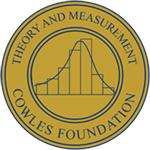Document Type
Discussion Paper
Publication Date
4-29-2021
CFDP Number
2284
CFDP Update Date
5-27-2021
CFDP Pages
55
Abstract
Background: A growing body of scientific evidence suggests that face masks can slow the spread of COVID-19 and save lives, but mask usage remains low across many parts of the world, and strategies to increase mask usage remain untested and unclear. Methods: We conducted a cluster-randomized trial of community-level mask promotion in rural Bangladesh involving 341,830 adults in 600 villages. We employed a series of strategies to promote mask usage, including free household distribution of surgical or cloth masks, distribution and promotion at markets and mosques, mask advocacy by Imams during Friday prayers, role modeling by local leaders, promoters periodically monitoring passers-by and reminding people to put on masks, village police accompanying those mask promoters, providing monetary rewards or certificates to villages if mask-wearing rate improves, public signaling of mask-wearing via signage, text message reminders, messaging emphasizing either altruistic or self-protection motives for mask-wearing, and extracting verbal commitments from households. The primary objective was to assess which of these interventions would increase proper (covering nose and mouth) wearing of face masks, and secondarily, whether mask promotion unintentionally creates moral hazard and decreases social distancing. This analysis is part of larger study evaluating the effect of mask-wearing on transmission of SARS-CoV-2.
Results: There were 64,937 households in the intervention group and 64,183 households in the control group; study recruitment has ended. In the control group, proper mask-wearing was practiced by 13% of those observed across the study period. Free distribution of masks along with role modeling by community leaders produced only small increases in mask usage during pilot interventions. Adding periodic monitoring by mask promoters to remind people in streets and public places to put on the masks we provided increased proper mask-wearing by 29.0 percentage points (95% CI: 26.7% - 31.3%). This tripling of mask usage was sustained over all 10 weeks of surveillance, which includes a period after intervention activities ended. Physical distancing, measured as the fraction of individuals at least one arm’s length apart, also increased by 5.2 percentage points (95% CI: 4.2%-6.3%). Beyond the core intervention package comprised of free distribution and promotion at households/mosques/markets, leader endorsements plus periodic monitoring and reminders, several elements had no additional effect on mask wearing, including: text reminders, public signage commitments, monetary or non-monetary incentives, altruistic messaging or verbal commitments, or village police accompanying the mask promoters (the last not cross-randomized, but assessed in panel data). No adverse events were reported during the study period.
Conclusions: Our intervention demonstrates a scalable and cost-effective method to promote mask adoption and save lives, and identifies a precise combination of intervention activities that were necessary. Comparisons between pilots shows that free mask distribution alone is not sufficient to increase mask-wearing, but adding periodic monitoring in public places to remind people to wear the distributed masks had large effects on behavior. The absence of any further effect of the village police suggests that the operative mechanism is not any threat of formal legal sanctions, but shame and people’s aversion to a light informal social sanction. The persistence of effects for 10 weeks and after the end of the active intervention period, as well as increases in physical distancing, all point to changes in social norms as a key driver of behavior change. Our cross-randomizations suggest that improved mask-wearing norms can be achieved without incentives that require costly monitoring, that aesthetic design choices and colors can influence mask-wearing, and that surgical masks with a substantially higher filtration efficiency can be a cost-effective alternative to cloth masks (1/3 the cost) and are equally or more likely to be worn. Implementing these interventions – including distribution of free masks, and the information campaign, reminders, encouragement – cost $2.30-$3.75 per villager, or between $8 and $13 per person adopting a mask. Combined with existing estimates of the efficacy of masks in preventing COVID-19 deaths, this implies that the intervention cost $28,000-$66,000 per life saved. Beyond reducing the transmission of COVID-19, mask distribution is likely to be a cost-effective strategy to prevent future respiratory disease outbreaks.
Recommended Citation
Abaluck, Jason; Kwong, Laura H.; Styczynski, Ashley; Haque, Ashraful; Kabir, Md. Alamgir; Bates-Jeffries, Ellen; Crawford, Emily; Benjamin-Chung, Jade; Benhachmi, Salim; Raihan, Shabib; Rahman, Shadman; Zaman, Neeti; Winch, Peter J.; Hossain, Md. Maqsud; Reza, Hasan Mahmud; Luby, Stephen P.; and Mobarak, Ahmed Musfiq, "Normalizing Community Mask-Wearing: A Cluster Randomized Trial in Bangladesh" (2021). Cowles Foundation Discussion Papers. 2616.
https://elischolar.library.yale.edu/cowles-discussion-paper-series/2616


